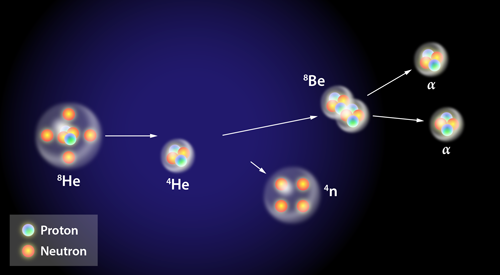 Take a look at your hand, while breathing some air: what are they made of? Our bodies, and more generally, matter is made of atoms, which, in turn, are made up of a small and dense nucleus orbited by electrons.
Take a look at your hand, while breathing some air: what are they made of? Our bodies, and more generally, matter is made of atoms, which, in turn, are made up of a small and dense nucleus orbited by electrons.
The atomic nuclei contain protons and neutrons, glued together by the strong (nuclear) interaction. Various types of atoms are defined by the number of protons (and electrons) they contain. Carbon has 6 protons, while Uranium, for example, 92. One hundred and eighteen elements are known today, four of which, elements 113, 115, 117 and 118, i.e. nihonium, moscovium, tennessine and oganesson, have been produced only in recent years.
Inside nuclei, the most attractive interactions occur between protons and neutrons. A proton and a neutron form a stable system, named deuteron, which is bound by an energy of 2.2 MeV (1 MeV corresponds to about 0.1% of the mass of the proton).
It has been an issue in nuclear physics for more than 50 years whether neutrons can form stable systems: do di-neutron or tri-neutron stable systems exist? Can four neutrons form a stable system?
While most of theoreticians concluded that neutrons do not bind together to form stable systems, the result of an experiment performed at RIKEN in Japan came as a shock, showing evidence for the possible existence of a “neutrons poker” – i.e. a tetraneutron structure.
The experiment, performed by a collaboration lead by Keiichi Kisamori ad Susumu Shimoura from the Center of Nuclear Study of the University of Tokyo, used a beam of high-energy radioactive helium nuclei, i.e.8He (this nuclei contains 6 neutrons and 2 protons, being the most neutron-rich helium isotope) directed on a liquid 4He target. The products of this reaction were analysed by the SHARAQ Riken’s high-resolution spectrometer.
The result of this reaction is a nucleus of 8Be and four neutrons. The 8Be itself decays in two 4He (also called (particle) nuclei, which were measured by the SHARAQ detector, see the reaction in Fig. 2. Knowing the energy of the 8He beam, and measuring that of the resulting 8Be, the “missing mass” method was used to deduce the energy of the remaining four-neutron system (since those neutrons were not directly measured). The Japanese scientists discovered evidence for a bound system of four neutrons – the tetraneutron, as a resonant system, namely an unbound state which exists long enough (of the order of 10-21 s) to potentially allow definition of a well-characterized state, in terms of spin, parity and energy. What the Japanese team found are four tetraneutron events, unbound by about 1 MeV. Four events are of course very few – how can then one be convinced that these events are indeed tetraneutron systems and not some fluctuation of some sort? The collaboration performed sophisticated analyses, similar to those done for the discovery of the Higgs boson, concluding that the statistical significance for the four discovered events is about 5 sigmas – usually enough to claim a discovery. In this case, however, due to some assumptions made by the scientists to consider the background, they referred to the four events as “candidate resonant state” (Phys. Rev. Lett. 116, 052501 (2016)).
While many nuclear physicists are still not convinced about the finding, the Japanese team is preparing a new experiment at RIBF in Japan, where, by using different techniques, they could confirm (or disprove) their finding.
In the meantime, theoreticians James Vary, Andrei Shirokov e collaborators performed sophisticated supercomputer simulations (Phys. Rev. Lett. 117, 182502 (2016)) where they confirmed the existence of a resonant tetraneutron state with similar characteristics to those reported by the Japanese experimental team.
The existence of the tetraneutron is yet to be confirmed. If confirmed, it would allow a refined study of the way in which this system is formed and of the nuclear interaction between more neutrons, a very hot topic in today’s nuclear physics. It might also allow a step forward in the understanding of the structure of the biggest clusters of neutrons known today: the neutron stars. These are believed to be bound structures of about 1057 neutrons, with a radius around 10 km. The structure of a neutron star and the way in which neutrons cling together in such a big system is yet to be understood, and the tetraneutron might help, even if it is a long way to go. But each journey starts with a first step! (Catalina Curceanu)

Fig. 2: The reaction used by Kisamori et al. to search for the tetraneutron system. A beam of high-energy radioactive 8He nuclei impinges on a 4He target, producing an energetic 8Be and a low-energy four-neutron system, 4n. The 8Be decays into two alpha (α) particles
 INFN-LNF Laboratori Nazionali di Frascati
INFN-LNF Laboratori Nazionali di Frascati